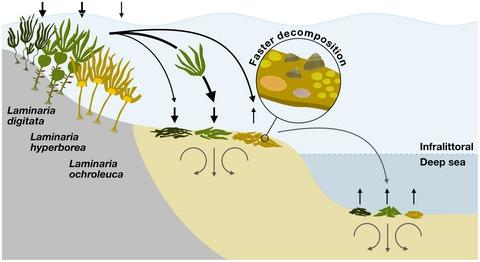当前位置:
X-MOL 学术
›
Glob. Change Biol.
›
论文详情
Our official English website, www.x-mol.net, welcomes your
feedback! (Note: you will need to create a separate account there.)
Climate-driven shifts in kelp forest composition reduce carbon sequestration potential
Global Change Biology ( IF 10.8 ) Pub Date : 2022-06-13 , DOI: 10.1111/gcb.16299 Luka Seamus Wright 1, 2 , Albert Pessarrodona 2 , Andy Foggo 1
Global Change Biology ( IF 10.8 ) Pub Date : 2022-06-13 , DOI: 10.1111/gcb.16299 Luka Seamus Wright 1, 2 , Albert Pessarrodona 2 , Andy Foggo 1
Affiliation

|
The potential contribution of kelp forests to blue carbon sinks is currently of great interest but interspecific variance has received no attention. In the temperate Northeast Atlantic, kelp forest composition is changing due to climate-driven poleward range shifts of cold temperate Laminaria digitata and Laminaria hyperborea and warm temperate Laminaria ochroleuca. To understand how this might affect the carbon sequestration potential (CSP) of this ecosystem, we quantified interspecific differences in carbon export and decomposition alongside changes in detrital photosynthesis and biochemistry. We found that while warm temperate kelp exports up to 71% more carbon per plant, it decomposes up to 155% faster than its boreal congeners. Elemental stoichiometry and polyphenolic content cannot fully explain faster carbon turnover, which may be attributable to contrasting tissue toughness or unknown biochemical and structural defenses. Faster decomposition causes the detrital photosynthetic apparatus of L. ochroleuca to be overwhelmed 20 days after export and lose integrity after 36 days, while detritus of cold temperate species maintains carbon assimilation. Depending on the photoenvironment, detrital photosynthesis could further exacerbate interspecific differences in decomposition via a potential positive feedback loop. Through compositional change such as the predicted prevalence of L. ochroleuca, ocean warming may therefore reduce the CSP of such temperate marine forests.
中文翻译:

气候驱动的海带森林组成变化降低了碳固存潜力
海带森林对蓝色碳汇的潜在贡献目前引起人们极大的兴趣,但种间差异尚未受到关注。在东北大西洋温带,由于气候驱动的冷温带指状海带和海带以及暖温带海带向极地移动,海带森林的组成正在发生变化。为了了解这可能如何影响该生态系统的碳封存潜力(CSP),我们量化了碳输出和分解的种间差异以及碎屑光合作用和生物化学的变化。我们发现,虽然暖温带海带每株植物的碳排放量高出 71%,但其分解速度却比北方同类植物快 155%。元素化学计量和多酚含量不能完全解释更快的碳周转,这可能归因于对比组织韧性或未知的生化和结构防御。更快的分解导致L. ochroleuca的碎屑光合装置在输出后 20 天被淹没,并在 36 天后失去完整性,而冷温带物种的碎屑保持碳同化。根据光环境,碎屑光合作用可能通过潜在的正反馈循环进一步加剧分解中的种间差异。通过成分变化,例如L. ochroleuca的预测流行,海洋变暖可能会减少此类温带海洋森林的 CSP。
更新日期:2022-06-13
中文翻译:

气候驱动的海带森林组成变化降低了碳固存潜力
海带森林对蓝色碳汇的潜在贡献目前引起人们极大的兴趣,但种间差异尚未受到关注。在东北大西洋温带,由于气候驱动的冷温带指状海带和海带以及暖温带海带向极地移动,海带森林的组成正在发生变化。为了了解这可能如何影响该生态系统的碳封存潜力(CSP),我们量化了碳输出和分解的种间差异以及碎屑光合作用和生物化学的变化。我们发现,虽然暖温带海带每株植物的碳排放量高出 71%,但其分解速度却比北方同类植物快 155%。元素化学计量和多酚含量不能完全解释更快的碳周转,这可能归因于对比组织韧性或未知的生化和结构防御。更快的分解导致L. ochroleuca的碎屑光合装置在输出后 20 天被淹没,并在 36 天后失去完整性,而冷温带物种的碎屑保持碳同化。根据光环境,碎屑光合作用可能通过潜在的正反馈循环进一步加剧分解中的种间差异。通过成分变化,例如L. ochroleuca的预测流行,海洋变暖可能会减少此类温带海洋森林的 CSP。




















































 京公网安备 11010802027423号
京公网安备 11010802027423号